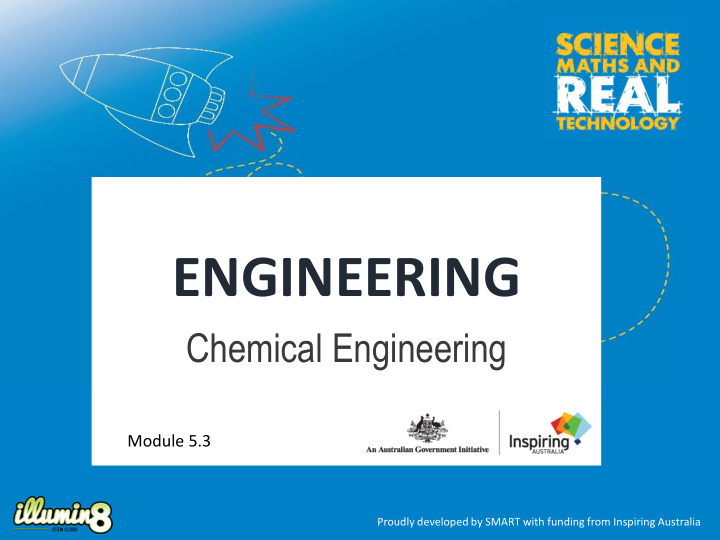



ENGINEERING Chemical Engineering Module 5.3 Proudly developed by SMART with funding from Inspiring Australia
Chemical Engineers Laura and Wade discussing their chemical engineering careers Video: https://www.youtube.com/watch?v=_UXwbxM8YfI Image source: http://myfootpath.com/careers/engineering-careers/chemical-engineer-careers/
Acid + Base Aim : To observe an acid base chemical reaction Materials (Facilitator demonstration): • 1 clear glass bottle / jar (wide top) • 1 cup white vinegar • Food colouring • A mixing bowl • Washing-up liquid • Paper-towel • Rubber band • Bicarbonate of soda ( 3 tablespoons) • Large baking tray / tub Image source: https://buggyandbuddy.com/science-for- kids-chemical-reactions-using-baking-soda-and-vinegar/ Procedure: 1. Stand the bottle / jar in the centre of the tray. 2. Mix the vinegar, a few drops of food colouring, and a squirt of washing up liquid together in the bowl. 3. Pour the mixture into the bottle. 4. Wrap the bicarbonate of soda in a small piece of paper-towel and secure with the rubber band. 5. Carefully place the bicarb soda package into the bottle. 6. Observe and document results.
What does Low numbers STRONG ACIDS 1 stomach acid the pH pH scale 2 lemon juice 3 vinegar tell us? 4 tomato 5 black coffee 6 milk pH = 7 7 pure water NEUTRAL: neither acidic or basic 8 Human blood 9 baking soda 10 Antacid tablet 11 ammonia 12 bleach 13 oven cleaner High numbers 14 drain cleaner STRONG BASES
H 2 O Water Molecules! H H 1 oxygen atom + 2 hydrogen O O atoms = 1 water molecule O δ - OH - 1 Hydrogen Ion + 1 Hydroxide H + Ion = 1 water molecule H H O Image source: SMART
pH Testing Aim : To observe the pH of common liquids Materials (per group): • 8 plastic cups, 1 marker • 30 ml lemon juice • 30 ml white vinegar • 30 ml brown vinegar • 30 ml lemonade • 30 ml Coca-Cola • 30 ml water • 30 ml milk • 30 ml liquid soap • 8 pH indicator test strips Procedure: 1. Use the marker to label each plastic cup with a different liquid: lemon juice, white vinegar, water etc. 2. Add 30 ml of each liquid to the correspondingly labelled cups. 3. Dip a pH indicator strip into each one of the liquids, follow the instructions for the strip on how long to leave it in. Observe the colour change. 4. Compare the colour of the strip to the indicator chart to decide the approximate pH of the liquid. 5. Repeat for the other 7 liquids.
Our Dig igestive System (pH 6.8) Mouth Oesophagus Stomach (pH 1.5 – 3.5) Liver Small Intestine (pH 6 – 7.4) Pancreas Large Intestine (pH 5.5 – 7) Rectum Appendix Anus
Tablet Coatings ENTERIC COATINGS Protect medicines from the acidic environment in our stomach, and protect our stomachs from the medicines. MODIFIED RELEASE COATINGS Help the drug release slowly and last longer, so we don’t have to take medicines so often. Image source: Pixabay.com
A new drug has been designed to treat a disease harming the small intestine. Hooray! The Problem: The clinical trials so far show that the new drug breaks down in the acidic environment of the stomach, so it never reaches the small intestine to help patients. Your Mission: You and your team of chemical engineers and gastroenterologists (doctors of the digestive organs!) have been asked to experiment with different tablet coatings, to find a coating which will allow the drug to reach the small intestine.
Engineering Process Image Source: http://www.sciencebuddies.org/engineering-design- process/engineering-design-process-steps.shtml#theengineeringdesignprocess
Rules • Your tablet coating needs to withstand the stomach solution for 5 minutes. • Coating effectiveness will be judged based on the colour of the stomach fluid after 5 minutes. If the fluid is still clear, and the lolly has kept its colour, the coating has worked! • If the coating is still intact after 5 minutes it will be put to the test with 2 minutes of stirring! • Tablet coating can be no more than 5 mm thick. Thinner coatings will get more points.
Materials • Skittles • 3 plastic cups for testing • Ruler (or callipers) • Lemon juice and lemonade solution • Flour (“stomach environment”) • Corn flour • Stop watch / timer • Vegetable Oil • Paper plate • Sugar • Plastic soon • Honey
Recommend
More recommend